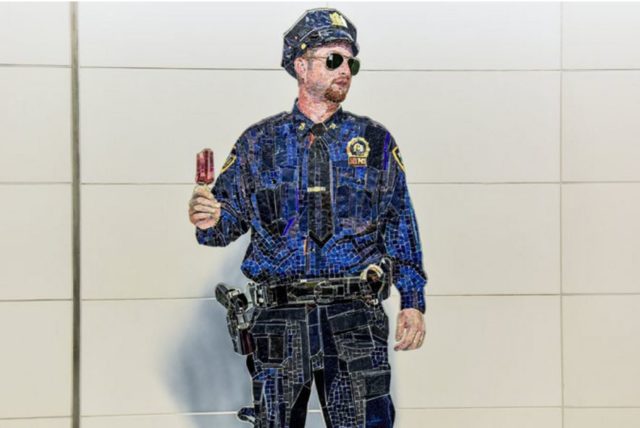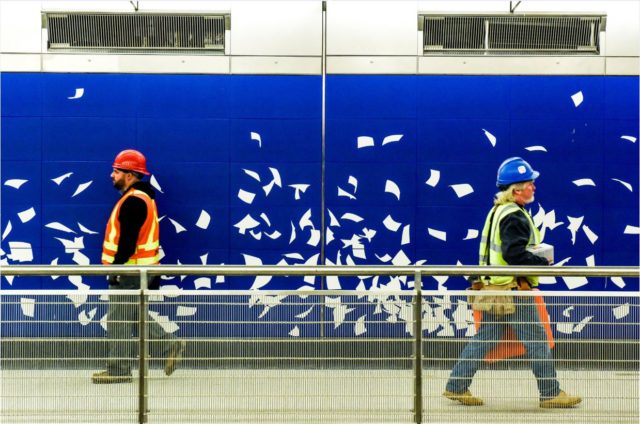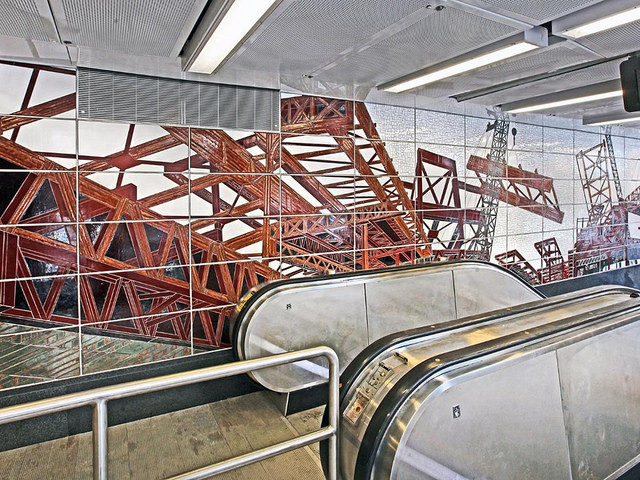
Detail from Vic Muniz, “Perfect Strangers,” photographed by George Etheredge for The New York Times.
Fingers-crossed, the first phase of the oft-delayed Second Avenue Subway is scheduled to finally open on New Years Day.
But maybe we can un-cross our fingers for at least one component of the problem-plagued project: the stations’ artworks look like they turned out much better than I expected. The MTA, Governor Cuomo, and publications such as The New York Times, have released a flurry of images of the installed works, and they’re a pleasant surprise. But admittedly, my expectations weren’t very high. I generally find most public art to be forgettable at best, and the initial renderings of the selected work elicited little more than a passing “meh” at the time, as well as some lingering questions.
I was curious, for example, about Sara Sze’s installation at the 96th Street station. I had only known the artist’s ultra-ethereal assemblages (indeed, when I first saw that the BMA had aquired her work “Random Walk Drawing (Eye Chart)” in 2012 my first thought was that it would be a conservator’s nightmare) which would obviously present a challenge to adapt to high-traffic areas.

Sara Sze’s “Blueprint for a Landscape” in the 96th Street mezzanine. Photo: George Etheredge for The New York Times
But in the 96th street mezzanine, Sze managed to capture a feeling of ephemerality in durable porcelain tiles, produced with artisans in Spain. The panels depict sheets of paper blowing in the wind, as if from an incoming train. For a motif that borders on cliché, it’s an unexpectedly beautiful moment. The traditional blue-on-white glazing technique recalls a cyanotype—as if the entire wall were a massive emulsive surface that had captured the shadow of a mundane moment in a sudden burst of subterranean sunlight.
![Sara Sze, "Blueprint for a Landscape" in the 96th street station. [photo via Governor Cuomo's Flickr]](http://artfcity.com/wp-content/uploads/2016/12/Sara-Sze-640x480.jpg)
Sara Sze, “Blueprint for a Landscape” in the 96th street station. [photo via Governor Cuomo’s Flickr]

Detail from Vic Muniz, “Perfect Strangers,” photographed by George Etheredge for The New York Times.
But overall, if there’s one cohesive theme to the four new stations’ works—selected by the MTA Arts & Design team, directed by artist/curator Sandra Bloodworth—it’s a willingness to test the limits of tile as a medium. Vik Muniz’s success in that department might just redeem some figures in his otherwise schlock-heavy work. There’s a painterly quality to his life-sized mosaic portraits, which alternate between delicate watercolor-like faces and chunky larger color blocks. This transition is most enjoyable in Muniz’s portrait of a policeman eating a popsicle (top of the page). The cop’s utility belt, gun, and pants fold into a strange cubist plane where distinctions between garment, anatomy, and weapons become confused. It adds to the already established sense of comical disarmament—his shooting hand is, after all, otherwise occupied.
Yet most of the figures in the tableau are harmless to the point of being toothless. The “kid with balloon” is such a trope of creative placemaking‘s visual language it almost reads like a self-aware pun. This is what we’ve come to expect from cheesy public art, and Muniz’s saccharine (no pun intended) oeuvre in general.

One of the self-portraits by Chuck Close in the 86th Street station. Photographed by George Etheredge for The New York Times.
You know what is an unexpected subject matter for public art? Self-portraiture. And yet Chuck Close has gifted two of these to New York posterity in his 86th Street Station mosaics. I can’t resist the temptation to view this gesture as the high-budget equivalent of someone tagging a subway car with their name. At the same time, I have to respect the weirdness of Close’s decision to include himself (twice) in the pantheon of cultural figures he’s depicted here: Philip Glass, Zhang Huan, Kara Walker, Alex Katz, Cecily Brown, Cindy Sherman, and Lou Reed. Like most of Close’s work, the portraits are technically impressive and visually arresting, but don’t leave me with much to say. Maybe that’s not necessarily a bad thing?

The entrance to Jean Shin’s “Elevated”, from the Flickr account of Governor Cuomo.
The biggest surprise in the Second Avenue Subway, though, is Jean Shin’s installation in the 63rd Street station. Prior to this commission, I was unfamiliar with her work, and it stands out as one of the most thoughtful considerations of the site. The station’s entrance is wrapped with mosaics depicting the demolition of the 2nd and 3rd avenue elevated line in the 1940s—one of the events that necessitated the long-delayed construction of the new underground spur. Elevator riders are encircled by rust-colored steel girders, depicted in a state of dis-assembly.

Jean Shin, “Elevated”, from the Flickr account of Governor Cuomo.
Paradoxically, as riders descend underground to the mezzanine, the mosaics depict blue sky, reflecting the “opening-up” of the streetscape following the elevated line’s removal. Black-and-white figures based on archival photos meander under a phantom silhoutte of the former rail line—like the passengers who will use the station, they seem to be waiting for the new train. The difference is, theirs took more than half a century to arrive. The experience of moving through the space looks as if it will be a cinematic one, recalling the great, almost forgotten tradition of using architectural ornamentation and the viewer’s movement to convey a narrative. Here the story feels like a parable about the notion of “progress.”
Shin’s piece promises to be so effective because it integrates with the space much more deliberately than in the other three station. Contemporary art and contemporary architecture are almost always strange bedfellows, and here it’s nice to see them conceive a promising viewing experience. But even if the other 3 artists’ works feel a little clumsily tacked to their sites, they’re a surprisingly decent starting collection for a project Governor Cuomo describes as “a museum underground.”


Comments on this entry are closed.
{ 6 trackbacks }